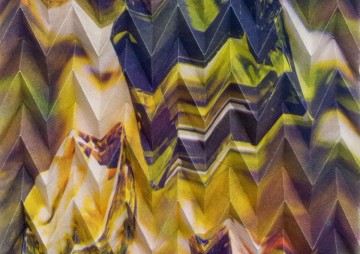Lydia Wilhelm
SCHERE, STEIN, PAPIER
November 14, 2015 – December 31, 2015
Constitutional Isomers, Diastereomers, Enantiomers, Conformes, Rotamers – they all are models and classifications that are used in stereochemistry to describe the spatial construction of chemical bonds. Aristotle already discovered the importance of classifying nature in order to get a general overview.
Lydia Wilhelm presents in her first solo show at widmertheodoridis a specially conceived installation accompanied with a series of photographs and works on paper.
Constitutional Isomers, Diastereomers, Enantiomers, Conformes, Rotamers – they all are models and classifications that are used in stereochemistry to describe the spatial construction of chemical bonds.
Aristotle already discovered the importance of classifying nature, in order to get a general overview. On the base of field observations he examined the types and principles of the alteration process. Using his differentiation method of form and matter Aristotle was able to describe the genesis and the perishability. Nature was created according to a consistent plan that full fills when everything materialises its own purpose and hence accomplishes its nature.
In ‚Schere, Stein, Papier’ (Rock, Paper, Scissors) Lydia Wilhelm also brings her system into order. Her folded photographs reminding of pleated fabric superpose underlying alpine faults and restitute visual order. For ‚Einsicht’ Wilhelm uses drawings from professional journals and shapes them to three-dimensional crystal models. Or she sets-up an experimental arrangement by using more than two thousand metal spheres to track down disorder.
Originating from Disentis in the region of Grisons, Wilhelm is well aware of the powers within the plate tectonics. This force has pushed together continents and raised huge mountain massifs up to thousands of meters. In her work ‚Umordnung’ Wilhelm tames this apparent chaos by folding perfect pleats and thus transforms a two-dimensional image into a three-dimensional figure.
She stays on track and continues to pursuit these geological and chemical phenomena by forming three dimensional crystal objects from a stereochemistry textbook. In her work ‚Einsicht’ (Insight) she documents the classified diversity in nature by placing these crystal objects on their archival boxes and neatly lining them up in the exhibition space.
The flow of time and the metamorphosis of things are both corner stones in Wilhelm’s work, just as in Aristotle’s philosophy and systemology. In her new work Wilhelm examines exactly these questions. Using more than two thousand, precisely aligned metal balls she carries out a trial to register movement and hence to prove the base of life.
Lydia Wilhelm lives and works in Winterthur. She studied Kunst und Vermittlung at the Hochschule Luzern and graduated with a Master Degree in Fine Arts from the Fachhochschule Nordwestschweiz in Basel. She received studio scholarships for Paris, Berlin and Reykjavik and had many exhibitions most recently at the Kunsthalle Winterthur, Kunstmuseum Winterthur and Neuer Shed Frauenfeld.
Constitutional Isomers, Diastereomers, Enantiomers, Conformes, Rotamers – they all are models and classifications that are used in stereochemistry to describe the spatial construction of chemical bonds.
Aristotle already discovered the importance of classifying nature, in order to get a general overview. On the base of field observations he examined the types and principles of the alteration process. Using his differentiation method of form and matter Aristotle was able to describe the genesis and the perishability. Nature was created according to a consistent plan that full fills when everything materialises its own purpose and hence accomplishes its nature.
In ‚Schere, Stein, Papier’ (Rock, Paper, Scissors) Lydia Wilhelm also brings her system into order. Her folded photographs reminding of pleated fabric superpose underlying alpine faults and restitute visual order. For ‚Einsicht’ Wilhelm uses drawings from professional journals and shapes them to three-dimensional crystal models. Or she sets-up an experimental arrangement by using more than two thousand metal spheres to track down disorder.
Originating from Disentis in the region of Grisons, Wilhelm is well aware of the powers within the plate tectonics. This force has pushed together continents and raised huge mountain massifs up to thousands of meters. In her work ‚Umordnung’ Wilhelm tames this apparent chaos by folding perfect pleats and thus transforms a two-dimensional image into a three-dimensional figure.
She stays on track and continues to pursuit these geological and chemical phenomena by forming three dimensional crystal objects from a stereochemistry textbook. In her work ‚Einsicht’ (Insight) she documents the classified diversity in nature by placing these crystal objects on their archival boxes and neatly lining them up in the exhibition space.
The flow of time and the metamorphosis of things are both corner stones in Wilhelm’s work, just as in Aristotle’s philosophy and systemology. In her new work Wilhelm examines exactly these questions. Using more than two thousand, precisely aligned metal balls she carries out a trial to register movement and hence to prove the base of life.
Lydia Wilhelm lives and works in Winterthur. She studied Kunst und Vermittlung at the Hochschule Luzern and graduated with a Master Degree in Fine Arts from the Fachhochschule Nordwestschweiz in Basel. She received studio scholarships for Paris, Berlin and Reykjavik and had many exhibitions most recently at the Kunsthalle Winterthur, Kunstmuseum Winterthur and Neuer Shed Frauenfeld.
Exhibition
November 14 – December 31, 2015
Opening reception:
Saturday, November 14, 2015, 3–8 pm
3 pm
Opening reception
4 pm
Welcome address
Hot soup
Traditional buns by bakery Bisegger
6 pm
Exhibition tour
Sunday, November 15, 2015, 11 am–4 pm
Long weekend:
Saturday, December 12, 2015, 11 am–9 pm
Sunday, December 13, 2015, 11 am–4 pm
Opening hours:
Wednesday, Thursday, Friday 2–6 pm
Saturday 11 am–4 pm
and by appointment
Opening reception:
Saturday, November 14, 2015, 3–8 pm
3 pm
Opening reception
4 pm
Welcome address
Hot soup
Traditional buns by bakery Bisegger
6 pm
Exhibition tour
Sunday, November 15, 2015, 11 am–4 pm
Long weekend:
Saturday, December 12, 2015, 11 am–9 pm
Sunday, December 13, 2015, 11 am–4 pm
Opening hours:
Wednesday, Thursday, Friday 2–6 pm
Saturday 11 am–4 pm
and by appointment

